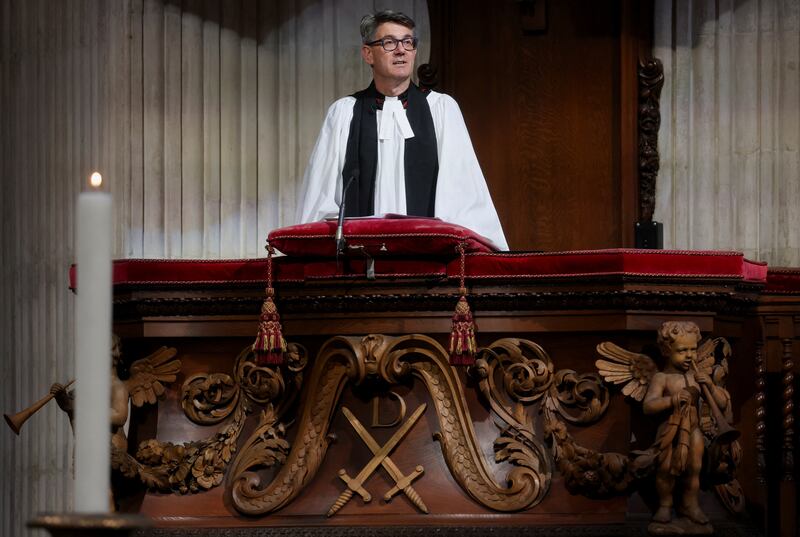Through the doors of St Paul’s Cathedral, the centuries flit in and out as they please.
On Sunday morning, the traffic rolls around the famous steps and spires, the staff in the Five Guys burger place across the street set up at a leisurely pace and beneath Sir Christopher Wren’s great dome, the spirits of Henry VIII and Ann Boleyn are invoked from the pulpit.
It is still summer in London: the promised winter of crises and bitter hardships seems faraway. But then, since the news of Queen Elizabeth’s death last Thursday, normalcy has been suspended and the city’s landmarks come alive to fulfil their purpose as touchstones of past and future.
It was to St Paul’s, on Friday evening, that King Charles III made his way after meeting, for the first time as sovereign, prime minister Liz Truss. Neither title trips off the tongue yet. But the backdrop was so familiar.
READ MORE
From St Paul’s, the new king made his first public address. By then, the entire pageant was in full flow and perfect synchronicity, live on television and the choir choreographed, with the pubs across the land busy and tea-time in the houses and history charging unassailably forth. The prayer service was led by the Rev Andrew Tremlett, the dean-designate of St Paul’s, the latest in a line of deans that includes John Donne.
Read more on Queen Elizabeth’s death
Queen Elizabeth’s coffin arrives in Edinburgh where it will remain overnight
Crowds turn out in rain to witness ‘moment in history’ at Hillsborough Castle
King Charles has ‘profound’ personal connection with Ireland
And on Sunday, Tremlett was back at the altar, a warm communicator and explaining to the gathering the origins of the term “Defender of the Faith” bestowed on Henry VIII and Catherine of Aragon by Pope Leo X in recognition of their defence against Lutheranism. A stained-glass window was to commemorate their valour.
“By the time the window was completed, Henry, the Defender of the Faith, had already fallen hopelessly in love with Ann Boleyn and was on a collision course with Rome. So, he switched sides.”

If you want to be thwacked over the head by the myths and weights of England’s monarchical past, then St Paul’s is happy to stun you. It has served as a magnet for history: the jubilees of Victoria, George and Elizabeth; the funerals of Churchill, Wellington and Thatcher. The black and white flagstone floor will, for older generations, instantly conjure the fated wedding procession of Diana and Charles more than 40 years ago.
That footage has acquired a doomy power because of the subsequent events and will, in time, become spliced with the latest visit of Charles to the cathedral, 73 years old now and ready to fulfil the role for which he has been waiting his entire life. Because the queen was 96 everyone knew this event was coming. Still, the suddenness of change has taken Londoners by surprise.
“My parents are in their mid-60s and they’ve never had another monarch,” says Rob Cummings (33), sitting in the courtyard near the cathedral.
“She’s spanned so many generations and eras and periods. It is the end of an era. It is so strange saying ‘King Charles’ and speaking of her in the past tense. It is a sad loss and a massive moment for London.”
In his day job as a tour guide, Cummings has witnessed daily the draw of the monarchy for visitors to London.
“Even in the dead of winter, the royal tour always has people. They love the history and buildings and the pomp and stories. I think it’s because you get more outrageous stories than you’ll get in any Hollywood movie,” he says. “Like Charles the Second, the merry monarch with his outlandish behaviour; Queen Victoria; Henry VIII, the spicy love life and that… and if you wrote them into a movie or TV series, you would think, that’s ridiculous, there is no way this person would ever exist. The monarchy is the one thing that keeps that mystique around England in particular.”
In front of the cathedral steps, Shrayes Raman and his mother, Indira Subramanian, have stopped to take photographs. Like many of those at the morning service, they are visiting the city. Raman was at a conference on Thursday when he heard the queen had died. A dedicated runner, he decided to go for a late-night jog through Hyde Park and along the Mall to the palace.
“I got there after about 1am. It was pretty incredible to see how immediately there were so many flowers. There were people there all through the night. It is a testament to what she meant to a lot of people, I guess, here, if they were willing to come out at that time.”
Raman’s grandfather was raised in India, studied in Sheffield and moved to Canada.
“We were all raised in Canada with God Save the Queen and Victoria Day and all these things commemorated. We certainly watched the weddings and all that,” says Indira.
She is a self-confessed Anglophile through frequent visits and growing up with British comedy and drama shows. But the mourning of a queen is, for all of London’s visitors, a strange phenomenon. The famous white cathedral is as good a place as any to try and understand it.
“Decay, ageing, the tent needing a bit more attention is part and parcel of the human condition: it is what we are,” says Rev Tremlett as the vergers and wandsmen float through the aisles and, around the city, the dusters and brass polish are applied to significant buildings. For the queen is coming.
“And the rituals which we will witness in the coming days are there to enable us to grieve as a nation.”






















